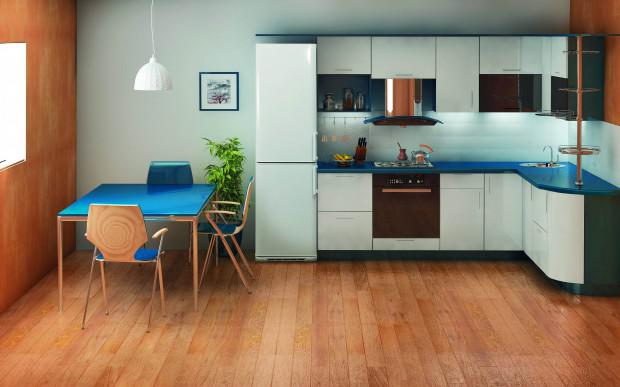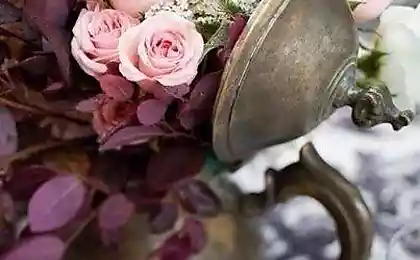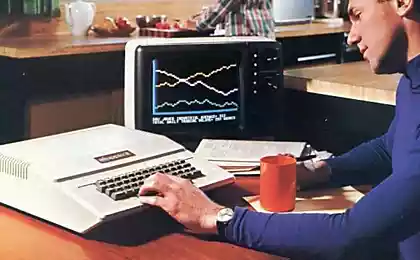941
10 surprising things that can be cracked by hackers
Hacking computers is no longer modeSoobscheniya about hackers in the media in the last few years appear very often. The objects are hacking government websites, game servers, services, online services, and attacks on these facilities has already destroyed the lives of millions of people around the world. In most reports of compromised devices as computers or smart phones appear, but this is not the only device that can be hacked. All that is connected directly to the Internet, or connect to the Internet through any wireless technology, is in the "at risk." This area includes such devices as ...
1. Televizory
Most modern TVs are no longer a simple device that receives the video signal via cable or satellite. Modern TVs can connect to the Internet, allowing them to gain access to a variety of applications and services. Research conducted by a number of computer security experts have shown that the "smart" TVs are just as vulnerable to hackers, as smart phones and computers. Malicious code can be embedded in them using Skype, as well as through social networks such as Twitter and Facebook. After this, a "smart" TV can be used as part of a botnet, a hacker can use the built-in TV cameras to spy on people. Another company involved in computer security, gave details on how to use some of the TV allows hackers to steal confidential user information stored in so-called cookies-files. To obtain this data, the hacker would just be within a radio apparatus. A special exploit also allowed hackers to download the TV user personal files.
2. Tualety
Do you think that your toilet is one of the few things that will be completely safe from hackers? Well, some of us believe that electric toilets - a way of the future, and therefore are the toilets quite common, especially in Japan. The company Trustwave, dedicated to the protection of software in 2013 was discovered a problem with electric toilets. Many of them can be controlled by applications that connect to the toilet via Bluetooth. The toilets are special Bluetooth PIN-codes, so to work with such toilet can anyone with the device, a suitable application. Such a person will be able to control multiple functions in the toilet. For example, to enable continuous flushing, opening or closing the lid, or even include a bidet water jet to spray water on the floor under a high pressure.
3. Printery
Many researchers have found ways to hack printers. Using certain vulnerabilities, they were able to introduce malicious code into the firmware of the printer, and thus bring it under control. Using exploits made possible because many modern printers now use technology to Wi-Fi, so that people can print your documents wirelessly. Researchers believe that gaining control of printers, they can perform a variety of actions, up to the destruction of the printer. Some printers are equipped with thermal chips that the printer is turned off when overheated. This helps improve the fire safety of these devices. An attacker can repeatedly cause overheating of the printer, as long as it does not burn completely. Other threats are related to the fact that hackers have the ability to steal the information printed on the printer. Also do not forget that the malicious code in the firmware of the printer is very difficult to remove, because the traditional antivirus solutions in this case do not work.
4. Keys to mashiny
To unlock the doors or start the engine, many modern cars no longer need a physical key. To do all this, the driver is sufficient to carry an electronic key. Car reads the signal from the electronic key, after which it will be possible to open the doors and start the engine. There are many ways in which hackers cheat cars, causing them to "think" that they have a genuine electronic key. One such method is a rough selection of the six-digit code of the machine brute force, which is also known as the «bruteforce». A more sophisticated method involves the use of two antennas close to the vehicle in order to strengthen key signal so that the car decided that it was her "home" key. Another way involves the use of "clean" key and inexpensive set of equipment to intercept signals from the real key. The resulting data is intercepted by an attacker can be used for making a duplicate of the electronic key.
5. Bankomaty
A little known fact about ATMs: approximately 95% of them are running Windows XP. This alone makes them vulnerable to the widest range of hacker attacks, specifically designed for this operating system, which even today is one of the most popular in the world. But the more serious problem lies in the fact that Microsoft has discontinued support for the system earlier this year. This means that the system will no longer receive security updates, which remove the detected vulnerabilities. As a result, those who are still using this system, will in time become very vulnerable. Nevertheless, a lot of banks around the world still use the ATMs Windows XP, because the transition to another system requires huge investments in new ATMs, and in the new system. As a result, many ATMs are a tasty morsel for hackers who can steal banking information, and may engage in cloning credit cards.
6. Holodilniki
In 2013, the California-based security company Proofpoint has revealed the vulnerability of the global household appliances. The strangest thing that this vulnerability had been exposed to the devices that we use every day - refrigerators. At the very least, the latest "smart" refrigerators that allow their owners to remotely monitor the temperature, keep food in a certain order, and run a variety of useful applications. Smart refrigerators can be broken, because the vast majority of owners leaving passwords on these devices, as they were in default, or because the safety functions of the refrigerator is not configured properly. The thing is that people do not perceive refrigerators as devices that may be subject to hacker attacks. Meanwhile, hackers have used refrigerators in their botnets and use them to send out spam, what the owners of these devices do not even know, because compromised refrigerators continue to operate normally.
7. Radionyani
Baby monitors have evolved over the last decade, and as a result have become very sophisticated devices, through which parents can monitor their children much better. However, their growing dependence on modern technology has led to the fact that they have also become a target for hackers. Some baby monitors emit a radio signal constantly, and if settings and passwords are left by default, it allows a hacker who is in range of the device to access the audio settings. And if the baby monitor support, and videos, it can be used by criminals to spy on the inhabitants of the room. A striking example of all of the above is the case where a baby monitor in the bedroom two-year child has been compromised, then the attacker got the opportunity to shout through its dynamics and control the camera. Fortunately, the child in the incident was fast asleep, but it should serve as a warning to parents. They need to understand that the protection of these devices is not the best.
8. Car tormoza
In vehicles for the operation of the important functions are increasingly used not mechanical, and electrical systems. More and more manufacturers of machines use electric brakes, rather than the traditional. Researchers from the University of California and the University of Washington were able to use the shortcomings in on-board computer systems of vehicles in order to take control of the brake of the machine. As a result, the researchers were able to use the brakes as they please, they are even able to selectively apply the brakes on different wheels, and in a manner to control the car. The researchers also demonstrated how you can completely disable the brakes, leaving the driver no single way to stop the car.
9. Svetofory
Experiments conducted by researchers showed that the lights can be hacked remotely. An attacker could change the sensor readings on the road, forcing them to pass false information. When the traffic lights road sensors reported that road jammed with cars, traffic lights begin to automatically adjust your regimen so as to pass through the intersection as much as possible machines. On the road sensors does not provide any data encryption, which makes it possible to change any information that comes from them at traffic control centers. Another hack uses a different function of modern traffic. This feature allows emergency vehicles and "soon" to pass through the intersection faster than others. Signals of such machines on the road lights to come from special sensors, and these signals are encrypted. However, hackers still can get access to some of the old system and to change traffic lights as they please.
10. Medical implantaty
Millions of people around the world depend on medical implants that support their health. With the development of high technology, these devices have become more innovative. For example, a pacemaker can now be controlled by special remote controls that allow to change the parameters of these devices without surgery. Alarmingly, these implants are very poorly protected. A number of researchers suggests that the implants have a number of security vulnerabilities because they use radio and other wireless signals to communicate between the remote, the computer and the implant, and hackers may well use this vulnerability to take complete control of an implant. Researchers are able to turn off the radio pacemakers by replication, but also able to change the regime, according to which the implant is filed another insulin to a patient. Both of these cases can cause serious health problems and even lead to death. Experts continue to insist that it is necessary to take urgent measures to ensure the safety of medical implants.
via factroom.ru
1. Televizory

Most modern TVs are no longer a simple device that receives the video signal via cable or satellite. Modern TVs can connect to the Internet, allowing them to gain access to a variety of applications and services. Research conducted by a number of computer security experts have shown that the "smart" TVs are just as vulnerable to hackers, as smart phones and computers. Malicious code can be embedded in them using Skype, as well as through social networks such as Twitter and Facebook. After this, a "smart" TV can be used as part of a botnet, a hacker can use the built-in TV cameras to spy on people. Another company involved in computer security, gave details on how to use some of the TV allows hackers to steal confidential user information stored in so-called cookies-files. To obtain this data, the hacker would just be within a radio apparatus. A special exploit also allowed hackers to download the TV user personal files.
2. Tualety

Do you think that your toilet is one of the few things that will be completely safe from hackers? Well, some of us believe that electric toilets - a way of the future, and therefore are the toilets quite common, especially in Japan. The company Trustwave, dedicated to the protection of software in 2013 was discovered a problem with electric toilets. Many of them can be controlled by applications that connect to the toilet via Bluetooth. The toilets are special Bluetooth PIN-codes, so to work with such toilet can anyone with the device, a suitable application. Such a person will be able to control multiple functions in the toilet. For example, to enable continuous flushing, opening or closing the lid, or even include a bidet water jet to spray water on the floor under a high pressure.
3. Printery

Many researchers have found ways to hack printers. Using certain vulnerabilities, they were able to introduce malicious code into the firmware of the printer, and thus bring it under control. Using exploits made possible because many modern printers now use technology to Wi-Fi, so that people can print your documents wirelessly. Researchers believe that gaining control of printers, they can perform a variety of actions, up to the destruction of the printer. Some printers are equipped with thermal chips that the printer is turned off when overheated. This helps improve the fire safety of these devices. An attacker can repeatedly cause overheating of the printer, as long as it does not burn completely. Other threats are related to the fact that hackers have the ability to steal the information printed on the printer. Also do not forget that the malicious code in the firmware of the printer is very difficult to remove, because the traditional antivirus solutions in this case do not work.
4. Keys to mashiny

To unlock the doors or start the engine, many modern cars no longer need a physical key. To do all this, the driver is sufficient to carry an electronic key. Car reads the signal from the electronic key, after which it will be possible to open the doors and start the engine. There are many ways in which hackers cheat cars, causing them to "think" that they have a genuine electronic key. One such method is a rough selection of the six-digit code of the machine brute force, which is also known as the «bruteforce». A more sophisticated method involves the use of two antennas close to the vehicle in order to strengthen key signal so that the car decided that it was her "home" key. Another way involves the use of "clean" key and inexpensive set of equipment to intercept signals from the real key. The resulting data is intercepted by an attacker can be used for making a duplicate of the electronic key.
5. Bankomaty

A little known fact about ATMs: approximately 95% of them are running Windows XP. This alone makes them vulnerable to the widest range of hacker attacks, specifically designed for this operating system, which even today is one of the most popular in the world. But the more serious problem lies in the fact that Microsoft has discontinued support for the system earlier this year. This means that the system will no longer receive security updates, which remove the detected vulnerabilities. As a result, those who are still using this system, will in time become very vulnerable. Nevertheless, a lot of banks around the world still use the ATMs Windows XP, because the transition to another system requires huge investments in new ATMs, and in the new system. As a result, many ATMs are a tasty morsel for hackers who can steal banking information, and may engage in cloning credit cards.
6. Holodilniki

In 2013, the California-based security company Proofpoint has revealed the vulnerability of the global household appliances. The strangest thing that this vulnerability had been exposed to the devices that we use every day - refrigerators. At the very least, the latest "smart" refrigerators that allow their owners to remotely monitor the temperature, keep food in a certain order, and run a variety of useful applications. Smart refrigerators can be broken, because the vast majority of owners leaving passwords on these devices, as they were in default, or because the safety functions of the refrigerator is not configured properly. The thing is that people do not perceive refrigerators as devices that may be subject to hacker attacks. Meanwhile, hackers have used refrigerators in their botnets and use them to send out spam, what the owners of these devices do not even know, because compromised refrigerators continue to operate normally.
7. Radionyani

Baby monitors have evolved over the last decade, and as a result have become very sophisticated devices, through which parents can monitor their children much better. However, their growing dependence on modern technology has led to the fact that they have also become a target for hackers. Some baby monitors emit a radio signal constantly, and if settings and passwords are left by default, it allows a hacker who is in range of the device to access the audio settings. And if the baby monitor support, and videos, it can be used by criminals to spy on the inhabitants of the room. A striking example of all of the above is the case where a baby monitor in the bedroom two-year child has been compromised, then the attacker got the opportunity to shout through its dynamics and control the camera. Fortunately, the child in the incident was fast asleep, but it should serve as a warning to parents. They need to understand that the protection of these devices is not the best.
8. Car tormoza

In vehicles for the operation of the important functions are increasingly used not mechanical, and electrical systems. More and more manufacturers of machines use electric brakes, rather than the traditional. Researchers from the University of California and the University of Washington were able to use the shortcomings in on-board computer systems of vehicles in order to take control of the brake of the machine. As a result, the researchers were able to use the brakes as they please, they are even able to selectively apply the brakes on different wheels, and in a manner to control the car. The researchers also demonstrated how you can completely disable the brakes, leaving the driver no single way to stop the car.
9. Svetofory

Experiments conducted by researchers showed that the lights can be hacked remotely. An attacker could change the sensor readings on the road, forcing them to pass false information. When the traffic lights road sensors reported that road jammed with cars, traffic lights begin to automatically adjust your regimen so as to pass through the intersection as much as possible machines. On the road sensors does not provide any data encryption, which makes it possible to change any information that comes from them at traffic control centers. Another hack uses a different function of modern traffic. This feature allows emergency vehicles and "soon" to pass through the intersection faster than others. Signals of such machines on the road lights to come from special sensors, and these signals are encrypted. However, hackers still can get access to some of the old system and to change traffic lights as they please.
10. Medical implantaty

Millions of people around the world depend on medical implants that support their health. With the development of high technology, these devices have become more innovative. For example, a pacemaker can now be controlled by special remote controls that allow to change the parameters of these devices without surgery. Alarmingly, these implants are very poorly protected. A number of researchers suggests that the implants have a number of security vulnerabilities because they use radio and other wireless signals to communicate between the remote, the computer and the implant, and hackers may well use this vulnerability to take complete control of an implant. Researchers are able to turn off the radio pacemakers by replication, but also able to change the regime, according to which the implant is filed another insulin to a patient. Both of these cases can cause serious health problems and even lead to death. Experts continue to insist that it is necessary to take urgent measures to ensure the safety of medical implants.
via factroom.ru























